

 |
 |
SPRING 2010 |
We take the 8.08am train service (international train) to
Amsterdam Airport
Schiphol. When we arrive at counter 27 for our
Arkefly flight to
Bonaire via Curaçao a long line of several hundreds of metres has formed
already. We have already checked in online and only have to drop off our bags,
but that is not what Arkefly counted on. We just have to queue up with the
rest. There are only three positions open for service, and that is clearly not
enough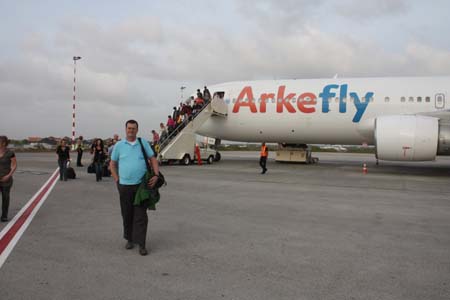 for the three flight that scheduled for this morning. After a while the drop
off window is opened, but we are not allowed to jump the queue. Then customer
start to ignore the instructions of the airport staff and we too go directly
to the front of the desk. Bad piece of organisation by Arkefly.
for the three flight that scheduled for this morning. After a while the drop
off window is opened, but we are not allowed to jump the queue. Then customer
start to ignore the instructions of the airport staff and we too go directly
to the front of the desk. Bad piece of organisation by Arkefly.
We drink coffee at Starbucks and wait for the departure of our flight. We have booked seats with extra leg room (at a surcharge). The flight runs smoothly. Extra payment is necessary for inflight entertainment, drinks and snacks. The meal is included, but tastes - even for airline standards - downright awfull, as does the wine. After 10 hours of flight we land at Curaçao. We have to leave the aircraft for a clean up. After an hour's wait we can reboard together with a new crew and passengers bound for Amsterdam. Our seats have been assigned to other people. Fortunately the flight to Bonaire takes only 15 minutes.
After arrival at Bonaire's Flamingo Airport the checking of the passports is very slow and so is the off loading of the bagage. We are in no hurry, it is our holiday. The bagage has to be scanned again, but the official gets fed up with the job after 15 bags or so and the rest of us can go through unchecked. The driver who was supposed to pick us up, has not showed up. We take a taxi. For $10 Albert drives us to the Divi Flamingo Resort on the outskirts of the island's tiny capital Kralendijk. Here we get a room above the reception area. A good thing, as we can use the free WiFi internet without leaving the room. Night has fallen and we go out for dinner. We stumble upon the nearby restaurant called Unbelievable, where we eat a decent dinner on the lovely roof terrace. We finally catch that holiday spirit.
After dinner we grab a stool at the beach bar of our hotel to drink our welcome cocktail. We are dead beat and go to bed around 9pm local time.
Weather: 30°C/86°F, cloudy
On this Easter Day we rise early. At 7am we are wide awake. We have breakfast with a sea view. Various types of birds try to steal our food and are not easily deterred. We even spot a crab.
After breakfast we walk to the on site Dive shop.
We register as divers. We have to pay $25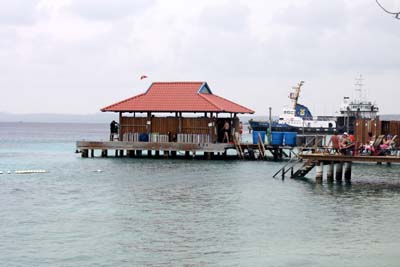 for a license to dive in the Bonaire National Marine Park. The entire coast
line belongs to the National Park. Snorklers pay only $10 for a year. We
receive a lable that we have to wear clear visible when diving. We have to
return by 9.30 for a lecture on diving around Bonaire. We are told to be
careful with the coral. Never to touch anything, it goes without saying. We
should avoid the North and East coast. That is way too dangerous. The rest
of the rules are very straightforward. Regisered divers get the use of a
locker on the diving dock, where you can store your dive gear and let it
dry. You do not have to slug your gear all the way to your room and back.
Brilliant system. The locker has a number. With this number you can register
for boat dives. You just write your number in a empty box on the white board
related to the boat dive you want to join. You can also do shore dives from
almost anywhere along the coast. The hotel's parking lot has storage for
filled air tanks. After the lecture we do a orientation dive, in front
of the Dive shop on the resort's own reef, called Calabas. I team up with
another single diver: Tim form Tennessee. There is a relatively shallow zone
with a sandy bottom of about 15 metres. Beyond that the
for a license to dive in the Bonaire National Marine Park. The entire coast
line belongs to the National Park. Snorklers pay only $10 for a year. We
receive a lable that we have to wear clear visible when diving. We have to
return by 9.30 for a lecture on diving around Bonaire. We are told to be
careful with the coral. Never to touch anything, it goes without saying. We
should avoid the North and East coast. That is way too dangerous. The rest
of the rules are very straightforward. Regisered divers get the use of a
locker on the diving dock, where you can store your dive gear and let it
dry. You do not have to slug your gear all the way to your room and back.
Brilliant system. The locker has a number. With this number you can register
for boat dives. You just write your number in a empty box on the white board
related to the boat dive you want to join. You can also do shore dives from
almost anywhere along the coast. The hotel's parking lot has storage for
filled air tanks. After the lecture we do a orientation dive, in front
of the Dive shop on the resort's own reef, called Calabas. I team up with
another single diver: Tim form Tennessee. There is a relatively shallow zone
with a sandy bottom of about 15 metres. Beyond that the
 bottom
drops off to some 30 to 40 metres. That is where all the nice corals start
that attracts the pretty reef fish. We go to about 18 metres. The fish are
wonderful and plenty. After some 36 minutes we return to base. We then go
for lucnch at the beach bar. We are not suitably dressed for the restaurant
(swim shorts and t-shirt), so we are kindly reffered to the beach bar. At
the bar I am attacked by mosquitoes. The bites start to swell and itch
enormously. After lunch we have a rest before we report for the afternoon
boat dive. The afternoon runs are one-tank trips, with one tank for one
dive. The morning runs are 2-tanks affaires, and thus two dives. We sail at
2pm to Klein Bonaire, a small uninhabited island off the coast near
Kralendijk, where jump in close to Monte’s
Divi. We dive against the stream along the drop-off. It is fantasic and
teeming with fish. The dive lasts about 45 minutes. It is the first dive
with my new underwater camera. I take lots of photos. After the dive we sail
back to the resort.
bottom
drops off to some 30 to 40 metres. That is where all the nice corals start
that attracts the pretty reef fish. We go to about 18 metres. The fish are
wonderful and plenty. After some 36 minutes we return to base. We then go
for lucnch at the beach bar. We are not suitably dressed for the restaurant
(swim shorts and t-shirt), so we are kindly reffered to the beach bar. At
the bar I am attacked by mosquitoes. The bites start to swell and itch
enormously. After lunch we have a rest before we report for the afternoon
boat dive. The afternoon runs are one-tank trips, with one tank for one
dive. The morning runs are 2-tanks affaires, and thus two dives. We sail at
2pm to Klein Bonaire, a small uninhabited island off the coast near
Kralendijk, where jump in close to Monte’s
Divi. We dive against the stream along the drop-off. It is fantasic and
teeming with fish. The dive lasts about 45 minutes. It is the first dive
with my new underwater camera. I take lots of photos. After the dive we sail
back to the resort.
After a shower we collect our car at the on site office of Hertz. We get a Suzuki Jimny, a small 4x4. We drive it to Cai, on the bay with that name. We get there by following dusty, unpaved roads. At Cai the Bonairians spend there Sunday afternoon picknicking, drinking and dancing to caribbean tunes. It is a happy affair. After an hour or so we head back to the hotel.
At night we have dinner at Donna & Giorgio, an Italian restaurant near our resort. The Italian food is fine and so is the service.
Weather: 29°C/84°F; cloudy with sunny spells
After the breakfast buffet we take the car for
spin to the North part of the island. We follow the coast, past numerous
dive spots. Beyond the relay transmitter of
Radio Netherlands World Service
we turn off inland towards Rincón.
This is the oldest settlement on the island, founded by the Spaniards,
away from the coast and possible hostile intruders. The soil is more
fertile here as well. Easter is a Christian and official holiday here
and the streets are all but deserted. There is a mass going on in the
large Catholic church and outside of it a barbecue is being prepared. We
continu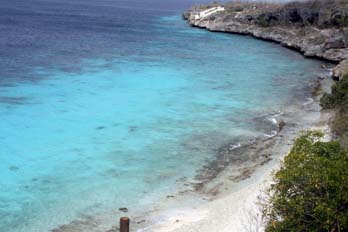 e
to the
Magazina di Rei, a former
royal warehouse from 1824 where up until 1863 the slaves had to collect
their payment on every Wednesday. It is the second oldest stone building
on the island and is now used as a community centre and a museum.
Further up the road we turn off the main road towards the North coast.
Here at Boca Onima we take a look at the indian
rock paintings. The exact meaning of the paintings is obscure,
but the rocks were no dwellings for the Arawak people who came here from
Venezuela. When the Spaniards arrived in the late 15th century (1499)
the Arawaks were deported to Hispaniola as forced labour, if they had
not succumbed to European contagious diseases, brought here by the same
Spaniards. The Arawak's immune system had no response to these
infections. We continue to Antriol where we turn left to Lagun.
From there a dirt road takes us to the now defunct light house of
e
to the
Magazina di Rei, a former
royal warehouse from 1824 where up until 1863 the slaves had to collect
their payment on every Wednesday. It is the second oldest stone building
on the island and is now used as a community centre and a museum.
Further up the road we turn off the main road towards the North coast.
Here at Boca Onima we take a look at the indian
rock paintings. The exact meaning of the paintings is obscure,
but the rocks were no dwellings for the Arawak people who came here from
Venezuela. When the Spaniards arrived in the late 15th century (1499)
the Arawaks were deported to Hispaniola as forced labour, if they had
not succumbed to European contagious diseases, brought here by the same
Spaniards. The Arawak's immune system had no response to these
infections. We continue to Antriol where we turn left to Lagun.
From there a dirt road takes us to the now defunct light house of 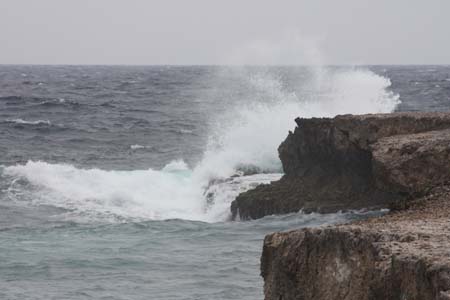 Spelonk.
Waves beat against the rocks here some of them up to 4 metres high.
Diving is impossible on the windy North side of the island. We drive
back and have some lunch at a Chinese food stand beside the road, called
Wai Kee snack. After the nutritious meal we head back for Kralendijk.
Spelonk.
Waves beat against the rocks here some of them up to 4 metres high.
Diving is impossible on the windy North side of the island. We drive
back and have some lunch at a Chinese food stand beside the road, called
Wai Kee snack. After the nutritious meal we head back for Kralendijk.
Back at Divi resort we lay about on the beach and enjoy doing nothing for a while. At night we have dinner at La Luna, a Dutch café no more than 5 minutes walking from our hotel. Later at night we have a drink on the dock of Karel's Beach Bar. The music is a bit loud, but it is a nice location catching some cool wind.
Weather: some light clouds, 30°C/86°F
We rise early. After breakfast we head for the
dive dock. I am going on the morning boat dive with one of Divi Dive's
boats. We sail at 10am with about
10
divers to the Southern part of the island and anchor at Punt Vierkant, a
dive sport near the coast. We dive to about 18 metres and swim along the
coral reef. We see lots of reef fish and great coral. Dive Master Luis
shows us the way. First upstream and after some 25 minutes we turn
around and continue down stream. Togheter with my dive buddy Tim a see
all sorts of fish like parrot fish, trumpet fish, yellow tail snappers
etc. Back on the boat I chat with a fellow diver from Atlanta who
dives here with his young son. He knows a lot about Europe and the
Netherlands and visits regularly. Our second dive is at Windsock near
the airport. We start again upstream towards a pier. There a lots of
juvenile fish underneath it. Jenne is now our dive master. Many of the
fish are very colourful, but unfortunately we see no rays, turtles or
sea horses. Maybe some other time. This dives is less deep, 8 metres on
average, but a lot longer in duration: over 51 minutes.
After the diving we go to the town centre for
coffee and some shopping. There is a cruise ship in port and the market
square is filled with stalls selling all kinds of tourist trinkets. The
streets are very busy and the shops are all open. We buy a adaptor for
my netbook computer,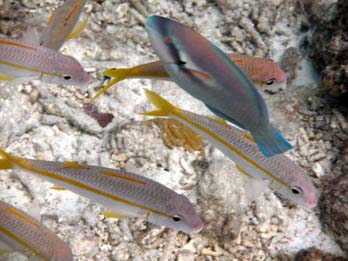 because the plug does not fit in any of the adaptors I have brought with
me. Bonaire uses American style plugs and sockets with flat contact
pins. The voltage is 110V AC. We have lunch at
City Café near the port. It is
a pleasant place to eat and moderately priced. After lunch we buy stamps
at the main post office.
because the plug does not fit in any of the adaptors I have brought with
me. Bonaire uses American style plugs and sockets with flat contact
pins. The voltage is 110V AC. We have lunch at
City Café near the port. It is
a pleasant place to eat and moderately priced. After lunch we buy stamps
at the main post office.
In the afternoon we drive to the salt lakes
in the South, where salt is recovered from sea water. The water is let
into basins where it evaporates, leaving the salt behind. It takes about
a year for the salt to fully crystalise. During the evaporation proces
the water turns increasingly pink. The salt is sweeped together and
exported by ship, mainly to the US where it is used for de-icing roads
in winter time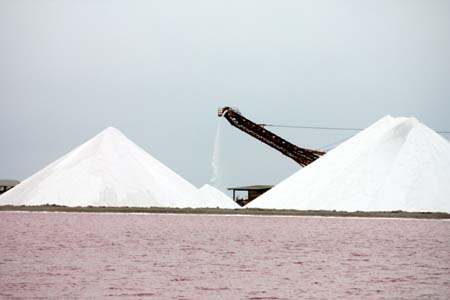 .
Until 1863 the salt lakes were worked by slaves imported from Africa.
The had to work under very bad circumstances. There skin suffered from
the salt and almost turned blind by the intense reflection of the
sunlight by the white salt. After abolition of slavery in 1863 the
salt industry became unprofitable and was discontinued until 1966 when a
US firm started up again. Now machines do what the slaves had to do a
century earlier.
.
Until 1863 the salt lakes were worked by slaves imported from Africa.
The had to work under very bad circumstances. There skin suffered from
the salt and almost turned blind by the intense reflection of the
sunlight by the white salt. After abolition of slavery in 1863 the
salt industry became unprofitable and was discontinued until 1966 when a
US firm started up again. Now machines do what the slaves had to do a
century earlier.
Further down the coast we see two groups of
former slave houses, where the slaves working in the salt pans had to
spend the night. The houses date back to 1850. Before that the slaves
had camp out under open sky. The slaves built the houses themselves with
wood and mud. For their pay and rations they had to walk all the way to
Rincón, some 27km North. Further down the coast we see some kite
surfers. At the southern tip of the island we see another deserted light
house. We drive back and catch a pre dinner drink at Karel’s bar. After
the drink we have dinner at Mona Lisa restaurant. W e have
reservations and that is just as well as the place is packed. The food
is fine. We have Wahi-carpaccio and barracuda. We forgot to take our
anti-mosquito spray and the insects make themselves noticed.
e have
reservations and that is just as well as the place is packed. The food
is fine. We have Wahi-carpaccio and barracuda. We forgot to take our
anti-mosquito spray and the insects make themselves noticed.
Back at the hotel we are greeted by a heavy rain storm lasting for ten minutes.
Weather: heavily overcast 28°C/82°F
Early morning were a woken up by a heavy rain storm
over Kralendijk. By the time we are ready for breakfast the rain has
subsided, but hotel staff is still busy mopping up the water. After
breakfast we take the car for a ride to the town centre where we have a
coffee at Café Mundo. We continue our journey up North to Lake
Goto. Here we see a couple of Caribbean parakeets up in the
trees. Not to be confused with the yellow shouldered parrot, which has
become quite rare. A bit further on we see flamingos searching for food
in the shallow and salty water. There is a cruise ship in port in
Kralendijk and we see minibusses with cruise passengers driving around
the lake. There is even a group on bicycles. After Lake Goto we drive to
Rincón for a drink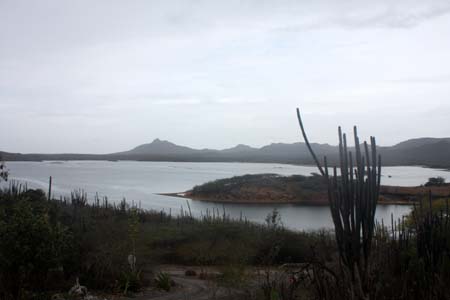 and to shop for a picnic lunch.
and to shop for a picnic lunch.
We drive on to Washington-Slagbaai National Park, stretching most of the Western part of the island. The park came into being after two privately owned estates were bequeathed to the state and merged to from this nature reserve. There are two routes on through the park. The long route is closed today because of earlier rainfall, but the shorter 24km drive is open and negotiable for cars. We see lots of cacti and lots of very tough growths surviving on the rather barren soil. The landscape is hilly. The rain has formed large pools of mud on the roads. With our Suzuki Jimny with 4WD we manage it nicely. We stop at bird observatory near a sweet water source. Here too we see the parakeets, but also some other birds like the Oriole and the Troupial. Along the road we see a gigantic iguana resting on a fallen tree. The route continues along the west coast and we arrive at another salt lake. There is a cafeteria here. This salt is also home to groups of flamingos, which we can observe at very close range. After 2.5 hours we are back at the entrance. Here is a tiny museum, which is only marginally interesting.
We drive back to. Around 3pm we are back at the
hotel. We have gotten tired by driving all those bumpy roads. We have a
break and when rain stops we sit
 outside
on our balcony. At some point in the afternoon there is a power cut (the
second this week) which lasts for about 90 minutes. Around 6pm we head
for nearbyj Unbelievable restaurant, which we already visited on
our first night here. The rain has started again. In our room we watch
some Dutch tv (BVN),
until there is another power cut at 9pm. Now we are in complete
darkness. We decide to drive into town and have a drink at Karel’s bar.
For a while we can sit dry under a large sun umbrella, but when the
rains gets heavier we move to the bar itself. Around 10pm the power is
cut even here and we have no choice other than to return to our room and
go to bed. Outside it continues to rain and around midnight the roof
starts to leak over Erik's bed. It gets
worse and we ask reception for another room. We get it rightaway and
continue our sleep in room 101. In the morning we wake up in a room with
sea view.
outside
on our balcony. At some point in the afternoon there is a power cut (the
second this week) which lasts for about 90 minutes. Around 6pm we head
for nearbyj Unbelievable restaurant, which we already visited on
our first night here. The rain has started again. In our room we watch
some Dutch tv (BVN),
until there is another power cut at 9pm. Now we are in complete
darkness. We decide to drive into town and have a drink at Karel’s bar.
For a while we can sit dry under a large sun umbrella, but when the
rains gets heavier we move to the bar itself. Around 10pm the power is
cut even here and we have no choice other than to return to our room and
go to bed. Outside it continues to rain and around midnight the roof
starts to leak over Erik's bed. It gets
worse and we ask reception for another room. We get it rightaway and
continue our sleep in room 101. In the morning we wake up in a room with
sea view.
The sun is out again when get up around 7am. We go
back to our old room a shower. After breakfast we move our bagage to our
new room. We go to the dive shop , where I will embark on the
Sunburst trip for my last two dives of this week. At 8.45 we
set out for Klein Bonaire, to the dive spot Forest. There is some current so we start up stream. I dive with Dive Master Mark. He
shows me some interesting fish, sea stars and sponges living on the
reef. Unfortnately my camera runs out of power - forgot to recharge -,
so taking pictures is not possible. We see two schools of barracudas.
Blue parrotfish, scorpion fish and lots of others. Just before we go
back to surface we see a large green sea turtle passing by. Just whne my
camera is not working! Mark takes a piece of orange in his mouth and the
French Angels fish immediately start picking , but they don't eat it.
is some current so we start up stream. I dive with Dive Master Mark. He
shows me some interesting fish, sea stars and sponges living on the
reef. Unfortnately my camera runs out of power - forgot to recharge -,
so taking pictures is not possible. We see two schools of barracudas.
Blue parrotfish, scorpion fish and lots of others. Just before we go
back to surface we see a large green sea turtle passing by. Just whne my
camera is not working! Mark takes a piece of orange in his mouth and the
French Angels fish immediately start picking , but they don't eat it.
We go back on board and go a bit east to the second dive spot of this morning, called Rockpile. There is a wide plateau before the gradual drop-off starts. We dive to about 15m and some beautiful animals like Queen Angel, various parrot fish, sponges, green eels and loads more. It sunny and the bright colours of the fish come out much better.
Back in the resort we hand in our gear and clear our locker on the dock. We go back to our room for a shower, have lunch and spend some time relaxing.
Later in the afternoon we have a cocktail at Karel's Beach bar. It is very hot in the sun, but with some wind it is not so bad. From Karel's we drive south to the salt lakes to watch the sun set. Just when we arrive the sun disappears behind the clouds. So we don't see much of a sunset. We then drive to the Capriccio. We have a lovely appetizer (Bresaola) followed by great Italian pizza.
Weather: scattered clouds with lots of sun. 31°C/88°F
We get up early and have breakfast. We head for
the direction of Lac. The road is blocked because road works and the
deviation a hardly signposted and we soon get lost. An elder lady in
a pick up truck helps us on our way in the right direction. When we
miss a turn off we try to turn around via the shoulder of the road
and almost get stuck in a marshy kind
of mud. Only with 4WD and low gear we manage to get out. We just
about manage to arrive in time in Lac at the
Mangrove Info
Centre for the 2 hour canoe tour through the Mangroves.
Our guide Ineke give us - before we board the vessels - a thorough
lecture on the significance of the Mangroves: filter for sand and
mud to protect the coral and a defense against floods. It is also a
nursery for various types of fish. In a group of around 13 people we
set off for a canoo tour in the Mangroves. We get a 2-seater canoe.
We manoevre through canals and tunnels made up of trees and roots.
We reach a bay which we have to cross facing the ocean wind. On the
other side we paddle through another circuit of very narrow canals
before we reach a clearing. We get out of the canoes and into the
water for some snorkling. We swim the length of a canal and see
fish, sponges and lots of root systems. The water is green and the
clarity is much less than in the open sea. The fish we see are
mostly mangrove snappers. We snorkle back to the canoe and paddle
back to base.
From
there we drive back to the hotel. Are room has been cleaned yet. We
take the car to central Kralendijk and have a coffee at our trusted
address El Mundo. There is cruise ship in port and the town centre
is abuzz with tourists. We have lunch at the City Café before we
return to the hotel. The room still has not been cleaned. We relax
at the beach until the room is done by 2.30pm (!).
Around 5pm we have a drink at the resort's beach bar. It is busy with Dutch ex-pats, who apperently have their weekly happy hour here. There is even a Bonairian band playing local music . There is free fruit punch and trays with Dutch hot snacks ("bitterballen") are being passed round. It gets too busy for our taste and we leave for a restaurant called Bambu, not far from the hotel. We have a table with a view of the port. The cruise ship has left port with lots of hooting of the horn and the berth is now occupied by very large freight ship. The food and service at Bambu are excellent. I take sashimi as an appetizer, followed by pork on skewer and rice. Erik takes salmon. We wash it down wtih a nice Chilean white wine.
Weather: sunny a over 32°C/90°F
We sleep in and wake up around 8.30. After
breakfast we take the car to the centre for a cup of coffee. We then
turn south round the southern tip of the island along the disused light
house. On our right hand is the wild coast and on our left the salt lake
and the flamingos. We carry on along the East coast until
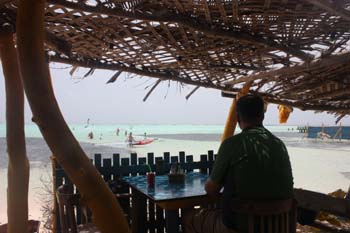 the Sorobon
naturist resort and stop at Jibe City
next door. Both resorts border on Lac Bay. Jibe City is a base for
windsurfers. We have coke at its beach bar and watch the windsurfers. We
drive on along the East coast for a while until we turn left for
Kralendijk. We have lunch at restaurant Appetite, a trendy place
with quiet inner court yard. We have some delicious sandwiches. After
lunch we drive back to the hotel an dake i easy for the remainder of the
afternoon.
the Sorobon
naturist resort and stop at Jibe City
next door. Both resorts border on Lac Bay. Jibe City is a base for
windsurfers. We have coke at its beach bar and watch the windsurfers. We
drive on along the East coast for a while until we turn left for
Kralendijk. We have lunch at restaurant Appetite, a trendy place
with quiet inner court yard. We have some delicious sandwiches. After
lunch we drive back to the hotel an dake i easy for the remainder of the
afternoon.
Around four o' clock we check out and head for
Flamingo Airport It is a small scale operation painted conspicuously in
pink. We return our car and check in for our flight. Our booked seats
are available. We have to pay $35 per head in departure tax. We
can pay it by credit card. We have drink in the cafeteria and watch the
Dutch football league on Dutch television. We negotiate through the
security checks and take a seat in the departure hall. Our aircraft
arrives an hour early from Curaçao. As all passengers are already
checked in and ready we board and leave an hour early. We are
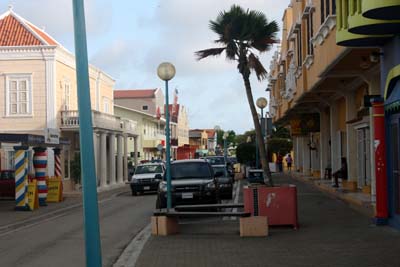 not
complaining. The flight is uneventful. The service is scaled down to the
bare minimum. Almost everything is at an extra charge, we do not get a
lot of servings, the food is awful and the wine too. The aircraft is
worn. The screens showing our position are blurry and turn black
regularly. We arrive in Amsterdam at 9.55am, where we are welcomed with
a 100% security check. That means that each passenger is checked by a
sniffer dog and has his carry on bagage x-rayed. Then a body scan
follows. In the bagage claim are are checked bags are scanned once more.
not
complaining. The flight is uneventful. The service is scaled down to the
bare minimum. Almost everything is at an extra charge, we do not get a
lot of servings, the food is awful and the wine too. The aircraft is
worn. The screens showing our position are blurry and turn black
regularly. We arrive in Amsterdam at 9.55am, where we are welcomed with
a 100% security check. That means that each passenger is checked by a
sniffer dog and has his carry on bagage x-rayed. Then a body scan
follows. In the bagage claim are are checked bags are scanned once more.
We take the 10.43 train to Rotterdam. It is around 11.45 when we are home again.
Other Travel